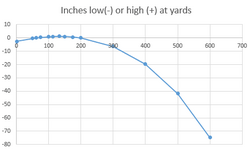Bronze Supporter
- Messages
- 517
- Reactions
- 450
"Rise relative to what?" is the question. Relative to the level ground, yes a bullet from a normally sighted rifle will rise. Relative to the line of the bore it will always fall.
Agreed, and that's why I said "from a certain point of view." (which, by the way, was a subtle Obi-Wan Kenobi reference, hehe). Just pointing out that "bullets rise when they come out of the barrel," doesn't quite fall in the implied category of "only an idiot 'expert' would say that." It's a true statement, from a certain, and reasonable, point of view. :-D
BTW, the numbers I used in my examples above were off the top of my head, and a little off, but here's a more accurate set of numbers representing bullet path...
Given my 16" barrel AR, 1:9 twist, 62gr M855, at a velocity of 3100ft/sec, a ballistic coefficient of 0.304, with the center of my scope being 2.68" above the bore, zero'd at 200 yards, no wind, on level ground, with all the targets lined up and level at the distances below, I've listed the bullet height above (+) or below (-) bullseye vertically.
Yards to Target / bullet high or low
1 yard / -2.6" (low)
50 yards / -0.4" (low)
61 yards / 0.0" (dead on bullseye, vertically)
75 yards / +0.4" (high)
100 yards / +0.9" (high)
113 yards / +1.1" (high)
133 yards / +1.2" (high, rough at the apex)
150 yards / +1.1" (high)
175 yards / +0.7" (high)
200 yards / 0.0" (dead on bullseye, vertically)
300 yards / -6.4" (low)
400 yards / 19.6" (low)
500 yards / 41.7" (low)
600 yards / 74.7" (low)
Here's a graph showing a side view (profile) of the bullet trajectory using the data above at between 1 and 300 yards.

Using the view between 0 and 300 yards helps accentuate the fact that the bullet, relative to ground/target, does, in fact, rise after it leaving the barrel.
Showing it out to 600 yards still shows the bullet rise (though not quite as well), but probably shows a better representation of the overall flatness over the first 2 hundred yards of the trajectory.

Note: Calculations performed using the Android app "Strelok Pro," and graph created in MS Excel.
-Skier
Last Edited:













